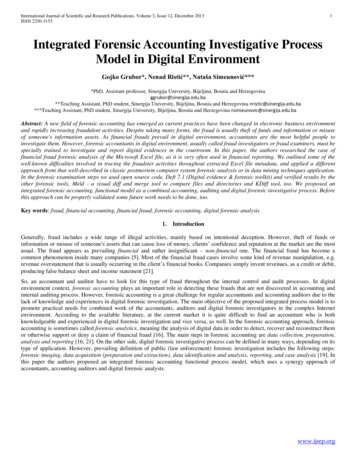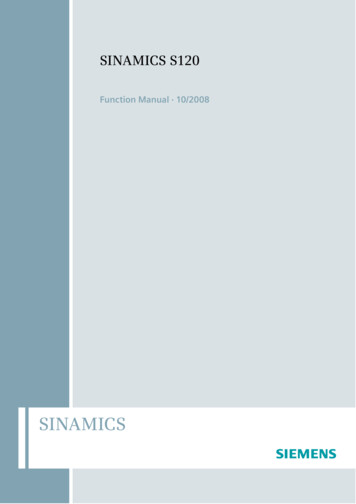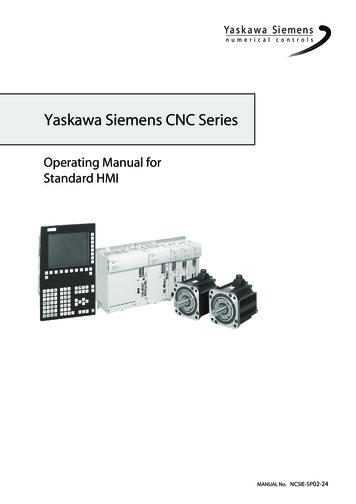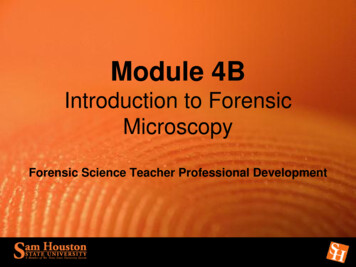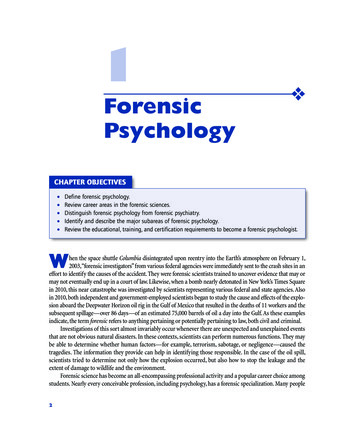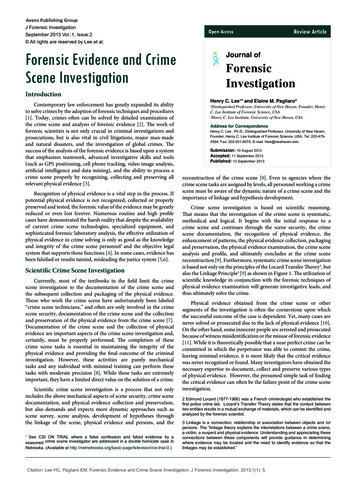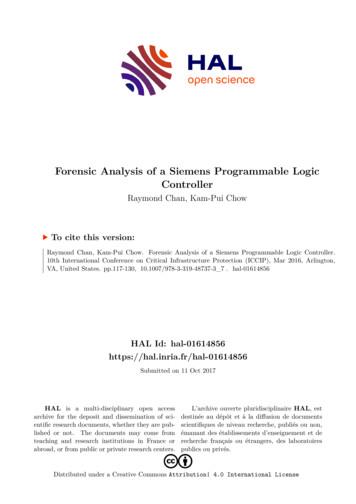
Transcription
Forensic Analysis of a Siemens Programmable LogicControllerRaymond Chan, Kam-Pui ChowTo cite this version:Raymond Chan, Kam-Pui Chow. Forensic Analysis of a Siemens Programmable Logic Controller.10th International Conference on Critical Infrastructure Protection (ICCIP), Mar 2016, Arlington,VA, United States. pp.117-130, 10.1007/978-3-319-48737-3 7 . hal-01614856 HAL Id: tted on 11 Oct 2017HAL is a multi-disciplinary open accessarchive for the deposit and dissemination of scientific research documents, whether they are published or not. The documents may come fromteaching and research institutions in France orabroad, or from public or private research centers.L’archive ouverte pluridisciplinaire HAL, estdestinée au dépôt et à la diffusion de documentsscientifiques de niveau recherche, publiés ou non,émanant des établissements d’enseignement et derecherche français ou étrangers, des laboratoirespublics ou privés.Distributed under a Creative Commons Attribution 4.0 International License
Chapter 7FORENSIC ANALYSIS OF ASIEMENS PROGRAMMABLELOGIC CONTROLLERRaymond Chan and Kam-Pui ChowAbstractProgrammable logic controllers are widely used in industrial controlsystems and supervisory control and data acquisition (SCADA) systems.As the potential of cyber attacks on programmable logic controllersincrease, it is important to develop robust digital forensic techniquesfor investigating potential security incidents involving programmablelogic controllers. This chapter focuses on the logging mechanism of aSiemens programmable logic controller, specifically the Siemens TotalIntegrated Automation Portal V13 program (Siemens TIA Portal, alsocalled Siemens Step-7).Keywords: Control systems, programmable logic controllers, forensic analysis1.IntroductionIndustrial control systems are vital to the operation of the critical infrastructure. Programmable logic controllers (PLCs), which are among the mostcommonly used components of industrial control systems, are used to monitor processes and perform control actions. Programmable logic controllers areusually connected to human-machine interfaces (HMIs) to enable remote realtime monitoring and control by human operators. Although modern industrialcontrol systems have been used for several decades, little research has focusedon forensic analysis methodologies for investigating security incidents involving control systems. The discovery of Stuxnet [10] in 2010 has significantlyincreased efforts to develop sophisticated and reliable forensic techniques forindustrial control systems, including programmable logic controllers. Thesetechniques are vital to understand the nature and scope of security incidentsand attacks, extract evidence and potentially identify the perpetrators.This chapter focuses on a Siemens programmable logic controller, namelythe Siemens Total Integrated Automation Portal V13 program (Siemens TIA
118CRITICAL INFRASTRUCTURE PROTECTION XPortal, also called Siemens Step-7), one of the systems targeted by Stuxnet.In particular, this chapter discusses the information available in the SiemensTIA Portal that could support forensic investigations and presents a forensicanalysis methodology for the Siemens programmable logic controller.2.Related WorkForensic analyses of industrial control systems are challenging due to thelack of access to and knowledge about proprietary devices and protocols [1].Taveras [7] has proposed a high-level model for live SCADA system forensics.Spyridopoulos et al. [6] have discussed the implementation of logging capabilities in a typical SCADA system architecture to support forensic investigations.Eden et al. [3] have presented an incident response taxonomy that includespossible attacks and forensic analysis methodologies for SCADA systems. Wuet al. [9] have proposed a forensic capability for the Siemens S7 programmablelogic controller that uses the Siemens TIA Portal to monitor changes to data.Patzlaff [5] has developed a forensic analysis framework for industrial controlsystems that covers programmable logic controllers as well as host computersand workstations.SCADA network forensics is also a topic of considerable interest amongresearchers and practitioners. Kilpatrick et al. [4] have proposed a SCADAnetwork forensic architecture for analyzing TCP/IP traffic between control devices. Valli [8] has developed a Snort intrusion detection system for SCADAnetworks, which is able to detect and respond to common network attacks.Analyzing programmable logic controller firmware is also of value in incidentresponse and forensic investigations. Basnight et al. [2] have discussed techniques for reverse engineering programmable logic controller firmware. However, the task is extremely time consuming and, due to the proprietary natureof the hardware and security mechanisms, it may not be possible to extractuseful information for forensic investigations.Little, if any, research has focused on practical approaches for performing forensic analyses on programmable logic controllers. To address the gap,this chapter presents a practical methodology for analyzing a Siemens programmable logic controller along with a computer workstation installed withthe Siemens TIA Portal.3.Forensic Analysis MethodologyFigure 1 summarizes the forensic analysis methodology. First, the forensic investigator identifies the computer workstations (PCs) and programmablelogic controllers (PLCs) involved in the security incident. Next, evidence is extracted from the workstations and programmable logic controllers for analysis.Further analysis has to be performed on the workstations that have the SiemensTotal Integrated Automation Portal V13 program (Siemens TIA Portal, alsocalled Siemens Step-7) installed. The identified programmable logic controllersmust be connected to the Siemens TIA Portal for further analysis. This section
119Chan & ChowFigure 1.Forensic analysis methodology.focuses on the forensic examination of the Siemens TIA Portal installed on aworkstation and a method for examining the diagnostics buffer in an affectedprogrammable logic controller.3.1Analyzing the Siemens TIA PortalThe Siemens TIA Portal is an integrated development environment for configuring and developing programs, and monitoring the status of the Siemensprogrammable logic controller. As such, it provides valuable information forforensic investigations.3.2Analyzing the PEData.plf FileThe PEData.plf project file is generated by the Siemens TIA Portal. Itcontains information about the programmable logic controller program andconfiguration. The PEData.plf file is generated when a new programmablelogic controller project is created. Because, the PEData.plf file records theprogrammable logic controller information in plaintext, any forensic tool (e.g.,WinHex) can be used to examine the information.
120CRITICAL INFRASTRUCTURE PROTECTION XFigure 2.Hex representation of the PEData.plf file.Analysis of the file contents revealed that all the project actions are stored inthe project file. Whenever the programmable logic controller program is modified, a PLUSBLOCK is appended to the end of the project file. The PLUSBLOCK provides information about the changes made to the programmablelogic controller program. By comparing the variable tags and the ladder logicregions in the PLUSBLOCK, a forensic investigator can obtain details aboutthe modifications made to the programmable logic controller program.Figure 2 shows the file structure of the PEData.plf file; the actions andmodifications are marked as COMMIT. It is possible to reconstruct the changesthat have been applied to the project file.Figure 3 shows the MAC times (last modification time, last accessed timeand creation time) of the PEData.plf file. The information is used to determinethe modification time, last access time and creation time of the project.Figure 4 shows the locations of the ladder logic program and tags in thePLUSBLOCK file. This information also enables a forensic investigator to examinethe changes made to the programmable logic controller program.3.3Analyzing the Program Block MetadataProgrammable logic controller programs are represented as program blocksin the Siemens TIA Portal. Each program block has its own metadata and
121Chan & ChowFigure 3.MAC times of the PEData.plf file.attributes. The information includes the size of the binary file, last compilationdate and last modified date of the programmable logic controller program.After an incident occurs, a forensic investigator needs to verify the correctness of the timestamp information provided by the programmable logic controller. Several timestamps are provided by the Siemens TIA Portal. Figure 5shows the compilation timestamp and the size of the program in memory.Figure 6 shows several useful timestamps associated with a programmablelogic controller program. The timestamps are:
122CRITICAL INFRASTRUCTURE PROTECTION XFigure 4.Storage locations of the ladder logic program and tags in PEData.plf.Block: This is the latest modification time of the programmable logiccontroller program. It is either the last modification time of the programblock interface or the code/data, depending on which entity was modifiedlast.Interface: This is the latest modification time of the interface of the programmable logic controller program. The interface timestamp is updatedwhenever the interface is modified.Code/Data: This is the latest modification time of the program logic ormetadata of the programmable logic controller program. The code/datatimestamp is updated when the program or metadata of the programblock are changed.Binary: This is the latest modification time of the metadata of theprogram block. It corresponds to the time when the compiled binarycomponent was loaded into the programmable logic controller.The compilation time (compilation timestamp in Figure 5) and last loadedtime (load-relevant timestamp in Figure 6) enable a forensic investigator toascertain when a program was compiled and loaded on the programmable logiccontroller. In a normal situation, the last loaded time should be after thecompilation time. If the last loaded time is earlier than the compilation time,then the program was (possibly updated and) compiled, but not yet loaded onthe programmable logic controller.
123Chan & ChowFigure 5.4.Program compilation information.Analyzing the Diagnostics BufferThe Siemens programmable logic controller has a diagnostics buffer thatrecords its behavior and interactions with the Siemens TIA Portal. For eachevent, the diagnostics buffer records the timestamp, event id and detailed description of the event. Since the buffer is read-only, it is not possible for an attacker to modify its contents. Due to the limited memory in the programmablelogic controller, the diagnostics buffer can only record about 1,300 to 3,000 recent events. During normal operation, the diagnostics buffer should be able torecord an adequate number of programmable logic controller events for forensic analysis. During an investigation, a forensic professional should switch theprogrammable logic controller from the RUN mode to the STOP mode beforeexamining the diagnostics buffer. Omitting this step may cause informationabout the earliest events to be overwritten by new events. Figure 7 shows theevent log maintained by the diagnostics buffer.4.1Starting and Stopping the ControllerThe Siemens programmable logic controller has three modes: (i) STARTUP;(ii) STOP; and (iii) RUN. When the programmable logic controller starts upwith a pre-loaded program, the diagnostics buffer records the mode change
124CRITICAL INFRASTRUCTURE PROTECTION XFigure 6.Program timestamp information.from STARTUP to RUN. If no program has been pre-loaded, then the modechange from STARTUP to STOP is recorded. The Siemens TIA Portal cansend commands to the programmable logic controller to change its mode. Twoevents are recorded after a STOP command is sent to the programmable logiccontroller and three events are recorded after a RUN command is sent to theprogrammable logic controller. Figure 8 shows the diagnostics buffer eventlog after the STOP and RUN commands are sent to the programmable logiccontroller.4.2Uploading a New ProgramIn order to upload a new program to the programmable logic controller, theSiemens TIA Portal has to change the programmable logic controller from theRUN mode to the STOP mode, overwrite the existing program with the newprogram and change the programmable logic controller mode to STARTUP.After the program is successfully uploaded to the programmable logic controller,the Siemens TIA Portal issues a WARM RESTART command to change themode from STARTUP to RUN, thereby enabling the newly-installed programto execute. The diagnostics buffer records a total of seven events until theupload action is completed. Figure 9 shows the corresponding event log in thediagnostics buffer.
125Chan & ChowFigure 7.4.3Diagnostics buffer event log.Analyzing Engineer-Defined EventsOther information is available that may be useful to determine the state ofthe programmable logic controller. For example, an engineer can set the diagnostics buffer to log events related to the running status of the programmablelogic controller that are helpful in investigating incidents. Figure 10 showsexamples of engineer-defined events that can be logged by the programmablelogic controller.5.Case StudyThis section describes a hypothetical, albeit realistic, security incident inwhich the proposed forensic analysis methodology is used to conduct the investigation.An engineer was dismissed from his position at a water supply company asa result of unsatisfactory performance. On December 26, 2015, the company
126CRITICAL INFRASTRUCTURE PROTECTION XFigure 8.Event log generated by sending a STOP command.incident response team received a call that the water supply system was downdue to a malfunctioning programmable logic controller. The incident responseteam was requested to investigate whether or not the system was attacked.After examining the CCTV recording, the dismissed engineer was identifiedas the primary suspect. Specifically, he was seen to access a workstation withthe Siemens TIA Portal installed. The incident response team believed that theengineer had modified the programmable logic controller program, which causedthe water supply system failure. The incident response team was tasked withidentifying the actions performed by the engineer and their times by examiningthe digital traces left in the Siemens TIA Portal and the diagnostics buffer ofthe programmable logic controller.The incident response team hypothesized that the engineer modified theprogram in question using the workstation and then uploaded the program tothe programmable logic controller. The team performed the following actionsand retrieved the following evidence according to the proposed methodology:The incident response team examined the workstation used by the engineer, which had the Siemens TIA Portal was installed. In the SiemensTIA Portal, the team discovered that the last modification time of theprogrammable logic controller program was 8/12/2015 3:05:58 PM, thecompilation time was 8/12/2015 5:46:36 PM and the last loaded time was8/12/2015 5:46:38 PM. These timestamps enabled the team to identifywhen the program had been modified and uploaded to the programmable
127Chan & ChowFigure 9.Figure 10.Event log generated by uploading a program.Engineer-defined events recorded by the diagnostics buffer.
128CRITICAL INFRASTRUCTURE PROTECTION XFigure 11.Figure 12.Program block timestamps in the Siemens TIA Portal.Program compilation/uploading timestamps in the Siemens TIA Portal.logic controller. Figures 11 and 12 show screenshots of the program blockinformation in the Siemens TIA Portal.The incident response team proceeded to identify the programmable logiccontroller with the abnormal behavior. After connecting to the pro-
Chan & ChowFigure 13.129Diagnostics buffer in the malfunctioning programmable logic controller.grammable logic controller, the team extracted the event log in the diagnostics buffer and discovered that the programmable logic controller hadbeen stopped and the modified program was executed on 26/12/20154:18:57 AM. The information provided by the diagnostics buffer provedthat the program was modified on 8/12/2015, which matched the dateof the water supply system failure. Figure 13 shows a screenshot of thediagnostics buffer in the malfunctioning programmable logic controller.Using the proposed forensic analysis methodology, the incident responseteam successfully extracted the programmable logic controller program modification time and compilation time from the Siemens TIA Portal to confirmwhen the program had been changed. By retrieving the event log from thediagnostics buffer in the programmable logic controller, the incident responseteam confirmed the time when the programmable logic controller was restarted.Upon comparing the program retrieved from the malfunctioning programmablelogic controller with the original program, the incident response team was ableto discover exactly how the program was modified and exactly what caused theprogrammable logic controller to malfunction. All the events were placed on atimeline by comparing the MAC times corresponding to the original programand the modified program.6.ConclusionsThe discovery of Stuxnet in 2010 has significantly increased efforts to develop sophisticated forensic techniques for industrial control systems. These
130CRITICAL INFRASTRUCTURE PROTECTION Xtechniques are vital to understand the nature and scope of security incidentsand attacks, extract evidence and potentially identify the perpetrators. Theproposed methodology for performing forensic analyses of programmable logiccontrollers is effective and practical. In particular, it focuses on a Siemensprogrammable logic controller along with a computer workstation installedwith the Siemens TIA Portal, one of the systems targeted by Stuxnet. Future research will extend the forensic analysis methodology to cover other programmable logic controller models and their associated firmware and software.References[1] I. Ahmed, S. Obermeier, M. Naedele and G. Richard, SCADA systems:Challenges for forensic investigators, IEEE Computer, vol. 45(12), pp. 44–51, 2012.[2] Z. Basnight, J. Butts and T. Dube, Analysis of programmable logic controller firmware for threat assessment and forensic investigation, Journalof Information Warfare, vol. 12(2), 2013.[3] P. Eden, A. Blyth, P. Burnap, Y. Cherdantseva, K. Jones, H. Soulsby andK. Stoddart, A forensic taxonomy of SCADA systems and approach toincident response, Proceedings of the Third International Symposium onICS and SCADA Cyber Security Research, pp. 42–51, 2015.[4] T. Kilpatrick, J. Gonzalez, R. Chandia, M. Papa and S. Shenoi, An architecture for SCADA network forensics, in Advances in Digital ForensicsII, M. Olivier and S. Shenoi (Eds.), Springer, Boston, Massachusetts, pp.273–285, 2006.[5] H. Patzlaff, D7.1 Preliminary Report on Forensic Analysis for IndustrialSystems, CRISALIS Consortium, Symantec, Sophia Antipolis, France,2013.[6] T. Spyridopoulos, T. Tryfonas and J. May, Incident analysis and digitalforensics in SCADA and industrial control systems, Proceedings of theEighth IET International System Safety Conference, 2013.[7] P. Taveras, SCADA live forensics: Real time data acquisition process todetect, prevent or evaluate critical situations, Proceedings of the First Annual International Interdisciplinary Conference, pp. 253–262, 2013.[8] C. Valli, Snort IDS for SCADA networks, Proceedings of the InternationalConference on Security and Management, pp. 618–621, 2009.[9] T. Wu, J. Pagna Disso, K. Jones and A. Campos, Towards a SCADAforensics architecture, Proceedings of the First International Symposiumon ICS and SCADA Cyber Security Research, pp. 12–21, 2013.[10] K. Zetter, Countdown to Zero Day: Stuxnet and the Launch of the World’sFirst Digital Weapon, Crown, New York, 2014.
programmable logic controller. Figure 8 shows the diagnostics buffer event log after the STOP and RUN commands are sent to the programmable logic controller. 4.2 Uploading a New Program In order to upload a new program to the programmable logic controller, the Siemens TIA Portal has to change the programmable logic controller from the




